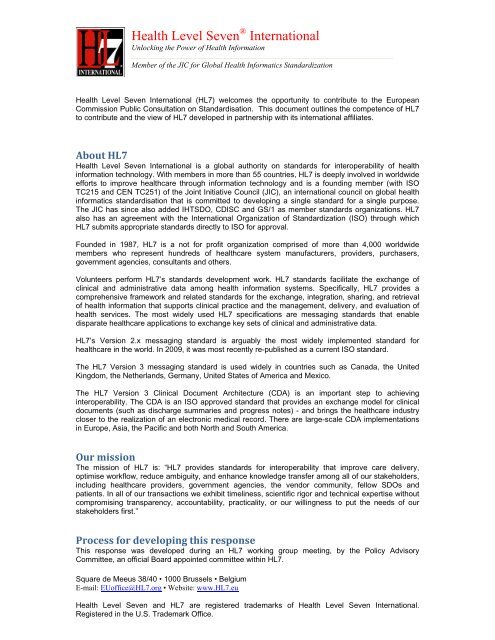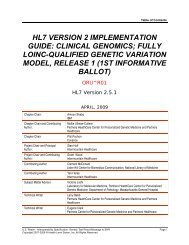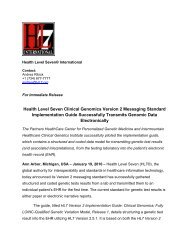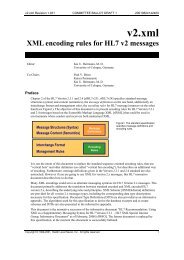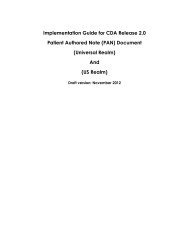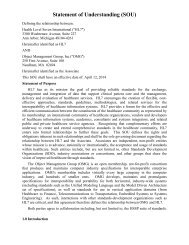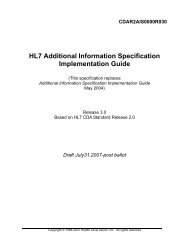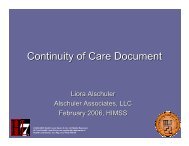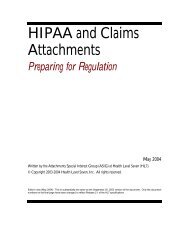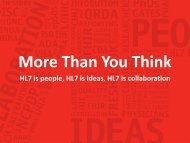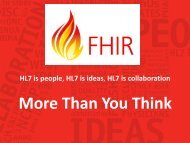Health Level Seven International - HL7
Health Level Seven International - HL7
Health Level Seven International - HL7
- No tags were found...
You also want an ePaper? Increase the reach of your titles
YUMPU automatically turns print PDFs into web optimized ePapers that Google loves.
<strong>Health</strong> <strong>Level</strong> <strong>Seven</strong> ® <strong>International</strong>Unlocking the Power of <strong>Health</strong> InformationMember of the JIC for Global <strong>Health</strong> Informatics Standardization<strong>Health</strong> <strong>Level</strong> <strong>Seven</strong> <strong>International</strong> (<strong>HL7</strong>) welcomes the opportunity to contribute to the EuropeanCommission Public Consultation on Standardisation. This document outlines the competence of <strong>HL7</strong>to contribute and the view of <strong>HL7</strong> developed in partnership with its international affiliates.About <strong>HL7</strong><strong>Health</strong> <strong>Level</strong> <strong>Seven</strong> <strong>International</strong> is a global authority on standards for interoperability of healthinformation technology. With members in more than 55 countries, <strong>HL7</strong> is deeply involved in worldwideefforts to improve healthcare through information technology and is a founding member (with ISOTC215 and CEN TC251) of the Joint Initiative Council (JIC), an international council on global healthinformatics standardisation that is committed to developing a single standard for a single purpose.The JIC has since also added IHTSDO, CDISC and GS/1 as member standards organizations. <strong>HL7</strong>also has an agreement with the <strong>International</strong> Organization of Standardization (ISO) through which<strong>HL7</strong> submits appropriate standards directly to ISO for approval.Founded in 1987, <strong>HL7</strong> is a not for profit organization comprised of more than 4,000 worldwidemembers who represent hundreds of healthcare system manufacturers, providers, purchasers,government agencies, consultants and others.Volunteers perform <strong>HL7</strong>’s standards development work. <strong>HL7</strong> standards facilitate the exchange ofclinical and administrative data among health information systems. Specifically, <strong>HL7</strong> provides acomprehensive framework and related standards for the exchange, integration, sharing, and retrievalof health information that supports clinical practice and the management, delivery, and evaluation ofhealth services. The most widely used <strong>HL7</strong> specifications are messaging standards that enabledisparate healthcare applications to exchange key sets of clinical and administrative data.<strong>HL7</strong>’s Version 2.x messaging standard is arguably the most widely implemented standard forhealthcare in the world. In 2009, it was most recently re-published as a current ISO standard.The <strong>HL7</strong> Version 3 messaging standard is used widely in countries such as Canada, the UnitedKingdom, the Netherlands, Germany, United States of America and Mexico.The <strong>HL7</strong> Version 3 Clinical Document Architecture (CDA) is an important step to achievinginteroperability. The CDA is an ISO approved standard that provides an exchange model for clinicaldocuments (such as discharge summaries and progress notes) - and brings the healthcare industrycloser to the realization of an electronic medical record. There are large-scale CDA implementationsin Europe, Asia, the Pacific and both North and South America.Our missionThe mission of <strong>HL7</strong> is: “<strong>HL7</strong> provides standards for interoperability that improve care delivery,optimise workflow, reduce ambiguity, and enhance knowledge transfer among all of our stakeholders,including healthcare providers, government agencies, the vendor community, fellow SDOs andpatients. In all of our transactions we exhibit timeliness, scientific rigor and technical expertise withoutcompromising transparency, accountability, practicality, or our willingness to put the needs of ourstakeholders first.”Process for developing this responseThis response was developed during an <strong>HL7</strong> working group meeting, by the Policy AdvisoryCommittee, an official Board appointed committee within <strong>HL7</strong>.Square de Meeus 38/40 • 1000 Brussels • BelgiumE-mail: EUoffice@<strong>HL7</strong>.org • Website: www.<strong>HL7</strong>.eu<strong>Health</strong> <strong>Level</strong> <strong>Seven</strong> and <strong>HL7</strong> are registered trademarks of <strong>Health</strong> <strong>Level</strong> <strong>Seven</strong> <strong>International</strong>.Registered in the U.S. Trademark Office.
Responses to the consultation questionsDo you think that service standards (including process standards) andalternative standardisation documents should be included in thescope of Directive 98/34/EC or its successor?<strong>HL7</strong> is not in a position to respond to this questionAre you aware of specific cases where national service standards andalternative standardisation documents have caused technical barriersto trade?<strong>HL7</strong> is not in a position to respond to this questionFor areas other than Information and Communication Technology(ICT), should it be possible to refer to documents developed by foraand consortia in legislation and public policies? If it should, howshould it be implemented?<strong>HL7</strong> is not in a position to respond to this questionHow could ESOs and NSOs be encouraged to accelerate theirstandards development process? Should for example the Communityfinancing for standardisation be subject to conditions in terms ofspeed of delivery whilst maintaining the openness of the process?It is not clear that ESOs and NSOs should accelerate standards development processes. Manystandards in the healthcare informatics sector have been developed by the ESOs however there islimited evidence of adoption and implementation by manufacturers into their product line. In contrast<strong>HL7</strong> products are supported and implemented by many product manufacturers.ESOs and NSOs should require implementation of the standard to be demonstrated before approvingthe standard. A standard published with clear evidence of utility and acceptance is more likely toprovide manufacturers with the confidence to adopt the standard in the marketplace and for theconsumers to appreciate and seek conformance to the standard.Community financing should be subject to conditions in terms of quality of the resulting standardmeasured by uptake by market, with conformance assertion, rather than speed of delivery. Thiswould incentivise ESOs and NSOs to produce standards relevant to the market rather than a largevolume of standards with restricted adoption and limited benefit.The collaborative development between ESOs, NSOs, industry fora and other standards developmentorganisations, based for example on the CEN TC251 participation through the Joint Initiative Council,could promote the quicker development of useful, robust standards without duplication of effort orconfusing the market place.Square de Meeus 38/40 • 1000 Brussels • BelgiumE-mail: EUoffice@<strong>HL7</strong>.org • Website: www.<strong>HL7</strong>.eu<strong>Health</strong> <strong>Level</strong> <strong>Seven</strong> and <strong>HL7</strong> are registered trademarks of <strong>Health</strong> <strong>Level</strong> <strong>Seven</strong> <strong>International</strong>.Registered in the U.S. Trademark Office.
Should the WTO principles of transparency, openness, impartiality,consensus, efficiency, relevance and consistency be integrated in thelegal framework of European standardisation (especially in EUDirective 98/34/EC or in its successor)? How should this beimplemented?The collaborative development between ESOs, NSOs, industry fora and other standards developmentorganisations, based for example on the CEN TC251 participation through the Joint Initiative Council,could promote the quicker development of useful, robust standards without duplication of effort orconfusing the market place.In general, domains such as healthcare should adopt existing standards from the general marketplace unless there is a compelling reason to develop a domain specific standard.Within healthcare and other safety critical industries there is a case for standards designed to meetthe requirements of the member states and the citizens of member states, alongside the needs ofmanufacturers in the market place. These standards may be referenced in member state and EUlegislation, such as standards for medical devices, pharmaceutical products and clinical records. Theimplementation should be sensitive to the societal challenges involved.Standards should include metrics for the benefits delivered by the standard; these benefits should bequantified using these metrics before review of the standard as part of the standards developmentprocess.How could the participation of consumer organisations,environmental NGOs, trade unions and social partners, and SMEs bebest promoted? What should be the role of public authorities(European Commission and Member States) in supporting such aparticipation in a transparent, open, impartial, consensual, efficient,relevant and consistent European standardisation system?Engagement with a broad range of stakeholders is important for a standard to have credibility in themarket place. ESOs should foster this engagement to promote confidence in their standards. Thequality criteria for a standard should include evidence that these stakeholders have been involved.How could the NSOs (National Standards Organisations) deepen theircooperation, and mutualise their activities? Could the following tasksbe shared amongst several NSOs?1. Management of the Secretariats of Technical Committees?2. Notification of new national standardisation projects?3. Promotion/sales of standards?4. Other?<strong>HL7</strong> is not in a position to comment on the operational practice of NSOs however <strong>HL7</strong> affiliates in theEU actively collaborate with the technical committees.Without prejudice to the national delegation principle, how could theEuropean Standards Organisations (ESOs) manage directly, on a caseby case basis, some standardisation activities, especially someTechnical Committees?<strong>HL7</strong> is not in a position to answer this question.Square de Meeus 38/40 • 1000 Brussels • BelgiumE-mail: EUoffice@<strong>HL7</strong>.org • Website: www.<strong>HL7</strong>.eu<strong>Health</strong> <strong>Level</strong> <strong>Seven</strong> and <strong>HL7</strong> are registered trademarks of <strong>Health</strong> <strong>Level</strong> <strong>Seven</strong> <strong>International</strong>.Registered in the U.S. Trademark Office.
What support should the European Commission provide to facilitatethe use of European standards as a means to open global markets?What would be the operational means that the Commission shoulduse? (Support experts’ participation in international standardisationactivities, translation of European standards into extracommunitylanguages?)<strong>HL7</strong> has found that successful support of standards depends on:Awareness of the standard. This can be achieved by education, training, inclusion in specificationsfor procurements, engaging manufacturers and consumers in the standards development activity.Low cost or no cost access to the standard reduces the initial barrier to awareness. The whole <strong>HL7</strong>standard suite is available to individuals for less than the cost of one standard published by ISO, theESOs and NSOs.Growing sufficient competence in the marketplace within member states and in other states tocorrectly adopt the standardA clear and credible means of asserting a product has conformance to the standardWhere appropriate, national profiles to ensure the standard is fit for the national market with nationaladoption guides.For the <strong>HL7</strong> community these criteria are already met, in particular through the <strong>HL7</strong> national affiliates.Under which conditions do you think that the European Commissioncould launch, on a case by case basis, calls for tenders, open to theESOs and to other organisations, to develop standards supporting EUpolicies and legislation?For such a call, each of the following criteria must be met:The call for the standard must support European Union policies and legislationThe business processes within the member states should be closely aligned with each otherThe proposed standard should support the business processes or lead to an agreed improvement inthe business processesThe standard should be required to include clear conformance criteria and a clear process to measureconformanceThe standard should have at least one implementation delivering the identified benefits of thestandard in at least three member states before becoming an approved standard.It is likely that <strong>HL7</strong> or some <strong>HL7</strong> national affiliates will consider the development of standards (orlocalisation/profiling of international standard) called for on this basis either alone or in participationwith other organisations developing standards. <strong>HL7</strong> aims to strengthen the European market throughcollaborative development of standards.The EU should ensure that such a call includes metrics for the quantified benefits of the standardsproduced and metrics for the measurement of conformance and adoption of standards.What is, in your view, the most efficient level of participation in theprocess of standards development: national, European, international?The most efficient level of participation will depend on the business circumstances. <strong>HL7</strong> operates atnational and international levels (and has established a European office for European developments).Ideally a standard would be developed as an <strong>International</strong> Standard by an accredited standardsdevelopment organisation with comprehensive contribution by a wide range of nations. In reality notall national communities will be able to contribute to all developments for a number of reasons:They may not yet appreciate the issue being addressedThey may not have the competence to contributeThey may have a fully worked up national solution but not wish to assign their intellectual property toISO, ESOs or a NSO. This is particularly common in healthcare where government funded standardsdevelopment has been successful. Where a substantial contribution of intellectual property is madeby a government, industry organisation or standards development organisation, the contributor shouldhave shared rights to the developed standard.Square de Meeus 38/40 • 1000 Brussels • BelgiumE-mail: EUoffice@<strong>HL7</strong>.org • Website: www.<strong>HL7</strong>.eu<strong>Health</strong> <strong>Level</strong> <strong>Seven</strong> and <strong>HL7</strong> are registered trademarks of <strong>Health</strong> <strong>Level</strong> <strong>Seven</strong> <strong>International</strong>.Registered in the U.S. Trademark Office.
A significant option, particularly where responsibility for the sector lies with the member state, is todevelop standards internationally supported by national profiles of use designed for the economicenvironment of the member state. Alternatively, an EU profile of standards, meeting the needs of allof the member states, would enable the EU marketplace to become less fragmented, more open andcompetitive.In your opinion, where is the major added value in Europeanstandardisation with respect to national standardisation?There is little development and sharing of national standards within the European Union throughoutthe healthcare informatics sector (and the majority of standards are developed at an <strong>International</strong>level). Regional standards are developed within member states. For example, within the UnitedKingdom standards are developed separately for England, Scotland, Wales and Northern Ireland.These standards are rarely compatible and reflect the different architectures of the healthcare deliveryenvironments in these regions.The European Union should adopt a profile of the <strong>International</strong> Standards to accommodate theconstraints of the EU marketplace (if any) whilst enabling EU manufacturers to compete in theinternational marketplace. Such a European standard, with sufficient specificity, would enable crossborderinteroperability and safe population migration within and beyond the EU however to date thestandards developed by ISO and the ESOs have not had sufficient specificity and have not had clearconformance criteria. The NSOs should work to provide a national profile of such a EuropeanStandard where this is necessary to accommodate the specific needs of the national community.<strong>HL7</strong>, through its national affiliates, operates on this basis. It additionally collaborates with ESOs, ISOand NSOs to ensure the standards developed are appropriate to the European marketplace.What are, in your view, the most serious barriers to the use ofstandards by enterprises: costs of standards (purchasing price)? Costsof operational implementation? Access to information? Knowledge ofexisting standards?There are six key barriers to the adoption of standards by manufacturers of healthcare informaticsproducts.Awareness: In the main, manufacturers are not aware of the standards available to use. Where theyare aware of standards, these are often those specified by nations for the products deployed in theirrealm. The free movement of healthcare case notes is essential for the free movement of citizenswithin and between member states and for the free market in healthcare service provision acrossmemberstates.Where standards supporting this objective have been set a number of nations have specified <strong>HL7</strong>developed standards.Cost: The current financial model for ISO, the ESOs and NSOs is based on free development and aseparate charge to gain awareness or understanding of each standard. This incentivises theauthorship of standards and specifications at the expense of the adoption of the standards andspecifications written.Education: Within the field of healthcare case notes and health informatics it is exceptional for ISO,the ESOs or NSOs to undertake any marketing initiative. Without marketing, education and training itis unlikely that manufacturers will be aware of the standards and specifications and even less likelythat they will have the competence to adopt them. <strong>HL7</strong> undertakes a wide range of educationalactivities to support the adoption of its standards and specifications. <strong>HL7</strong> standards are adopted inmany member states.Conformance assessment: For any standard to be of value to the purchaser of manufactured product(for <strong>HL7</strong> these are typically organisations delivering healthcare) needs to either benefit from the selfevidentbenefits of the standard or to be assured that the product conforms to the standard.Conformance is typically asserted in one of three ways:Self-assessment by the manufacturerThird party assessmentAssessment by the consumerSquare de Meeus 38/40 • 1000 Brussels • BelgiumE-mail: EUoffice@<strong>HL7</strong>.org • Website: www.<strong>HL7</strong>.eu<strong>Health</strong> <strong>Level</strong> <strong>Seven</strong> and <strong>HL7</strong> are registered trademarks of <strong>Health</strong> <strong>Level</strong> <strong>Seven</strong> <strong>International</strong>.Registered in the U.S. Trademark Office.
For health informatics there are no competent third party assessors for the ISO, ESO and NSOdeveloped standards and it is rare for a manufacturer to demonstrate conformance. <strong>HL7</strong>, through theIHE consortium, is able to demonstrate the use of <strong>HL7</strong> standards and the conformance of products to<strong>HL7</strong> standards is evidenced by the interoperation of different manufacturers products using IHEprofiles.Absence of useful standards: ISO, the ESOs and NSOs have rarely developed the standards requiredby the manufacturers of health informatics products. There are some standards with no evidence ofadoption in the market place. Other SDOs such as <strong>HL7</strong>, GS1, IHTSDO, World <strong>Health</strong> Organisationand CDISC are able to show implementations of their standards and specifications. Nevertheless,through the Joint Initiative Council, several implemented <strong>HL7</strong> standards have been published by ISOand CEN.Engagement in the development of standards: Manufacturers engaged in the development ofstandards are likely to adopt the standards. Although the cost of engaging in Standards Developmentthrough ISO, the ESOs and NSOs is notionally free, the meetings are often held outside Europe. Thisincreases the cost of participation significantly. <strong>HL7</strong>, through its international affiliates, is able to bringthe standards development practice closer to the manufacturer. In addition, <strong>HL7</strong> couples StandardsDevelopment with its extensive range of educational and competence assessment activities,subsidising the cost of participation and providing a broader range of benefits.What could the standards organisations do, in addition to theircurrent practice, to facilitate the access to standards, especially bySMEs?<strong>Health</strong>care organisations rarely operate in isolation. Patients will usually access healthcare servicesfrom a range of healthcare providers (hospitals, general practices, social services and schools toname just a few). Each of these businesses needs to be able to work in partnership with the otherorganisations chosen by the patient or selected by the purchaser of healthcare for the patient.Within healthcare providers it is rare for a provider to use a single solution for case notes. Often smalland medium sized organisations are able to provide niche solutions which address the needs of theclinical department and support the delivery of specialist clinical care. The deployment of a case notesolution for a general practice in an intensive care unit or emergency department is not likely to yieldsuccess.For SMEs focusing on healthcare case notes to benefit from the use of standards there is a range ofadditional requirements:The standards need to be appropriate. Historically, the standards developed by ISO and CEN haveaddressed problems which were not relevant to the SME market without addressing the need forstandards to enable SMEs to participate in the market. The standards developed by <strong>HL7</strong> are widelyused by SMEs to link to other providers of case note systems and to link to exchange case notes,schedule service provision etc. with products provided by other SMEs. It is for this reason that ISOand CEN are increasingly working with <strong>HL7</strong> to provide pertinent standardsThe SME needs to be aware that the standards are available. Currently there are several models forsharing standards with consumers (purchasers of product and product developers).ISO, CEN and NSOs publish their standards either in printed form or as electronic copy and chargefor each copy. Although schemes exist to ease the cost of access to the standards it is not possiblefor SMEs to determine whether they should invest in the document without purchasing the document.The NSOs do not invest in marketing the standards for CEN TC251 and ISO TC215. It is not clearthat, at least for case note products, the standards published in this form are widely read by SMEsStandards are funded by a variety of member nations and other states. A concept model andterminology for use in healthcare case notes is published by the <strong>International</strong> <strong>Health</strong> TerminologyStandards Development Organisation (IHTSDO) on this basis. Some, but not all, member statescontribute to IHTSDO. SMEs based in these member states have free access to the standards andthe products based on the standards. Product manufacturers shipping to other states pay a licencefee for the deployments in those states.<strong>HL7</strong> provides its standards free of charge to members of <strong>HL7</strong> or any of the national affiliates.Individual membership of an <strong>HL7</strong> affiliate typically costs less than one standard published by theNSOs. Adoption of <strong>HL7</strong> standards and specifications by SMEs is widespread. This is one of thereasons <strong>HL7</strong> standards and specifications are being used a number of EU projects and large scalepilots co-funded under the framework programmes of the European Commission.The standards must address the needs of the manufacturer and the needs of the purchaser of theproduct being manufactured. In particular, for healthcare, the standard needs to support the tailoringof the product to suit the bespoke needs of each member state’s economy and healthcare deliverySquare de Meeus 38/40 • 1000 Brussels • BelgiumE-mail: EUoffice@<strong>HL7</strong>.org • Website: www.<strong>HL7</strong>.eu<strong>Health</strong> <strong>Level</strong> <strong>Seven</strong> and <strong>HL7</strong> are registered trademarks of <strong>Health</strong> <strong>Level</strong> <strong>Seven</strong> <strong>International</strong>.Registered in the U.S. Trademark Office.
system. This is particularly true of detailed business and clinical process; business, healthcareprovider care delivery and payment differences that exist between countries and even individualfacilities within a country. For these reasons national and often local profiles of use for the standardsor specifications are often required. Within <strong>HL7</strong> this is achieved through national affiliates. It is rarefor a NSO to provide a national profile for an ISO or CEN standard or specification.<strong>HL7</strong> recommends that ISO, ESOs and NSOs work in partnership with the member states and theSDOs with domain specific expertise, such as <strong>HL7</strong> and IHTSDO. This form of public-privatepartnership is likely to have the capacity to both develop and publish standards suitable for largescale adoption throughout the market.Square de Meeus 38/40 • 1000 Brussels • BelgiumE-mail: EUoffice@<strong>HL7</strong>.org • Website: www.<strong>HL7</strong>.eu<strong>Health</strong> <strong>Level</strong> <strong>Seven</strong> and <strong>HL7</strong> are registered trademarks of <strong>Health</strong> <strong>Level</strong> <strong>Seven</strong> <strong>International</strong>.Registered in the U.S. Trademark Office.


